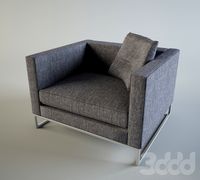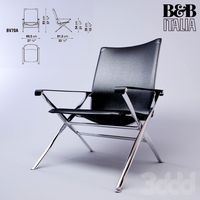GrabCAD

Convair B-58 Hustler
by GrabCAD
Last crawled date: 1 year, 11 months ago
The Convair B-58 Hustler, designed and produced by American aircraft manufacturer Convair, was the first operational bomber capable of Mach 2 flight.
The B-58 was developed during the 1950s for the United States Air Force (USAF) Strategic Air Command (SAC). To achieve the high speeds desired, Convair adapted the delta wing used by contemporary fighters such as the Convair F-102. The bomber was powered by four General Electric J79 engines in underwing pods. It had no bomb bay: it carried a single nuclear weapon plus fuel in a combination bomb/fuel pod underneath the fuselage. Later, four external hardpoints were added, enabling it to carry up to five weapons.
The B-58 entered service in March 1960, and flew for a decade with two SAC bomb wings: the 43rd Bombardment Wing and the 305th Bombardment Wing.[2] It was considered difficult to fly, imposing a high workload upon its three-man crews. Designed to replace the subsonic Boeing B-47 Stratojet strategic bomber, the B-58 became notorious for its sonic boom heard on the ground by the public as it passed overhead in supersonic flight.[3]
The B-58 was designed to fly at high altitudes and supersonic speeds to avoid Soviet interceptors. But with the Soviet introduction of high-altitude surface-to-air missiles, the B-58 was forced to adopt a low-level-penetration role that severely limited its range and strategic value. It was never used to deliver conventional bombs. The B-58 was substantially more expensive to operate than other bombers, such as the Boeing B-52 Stratofortress, and required more frequent aerial refueling. The B-58 also suffered from a high rate of accidental losses. These factors resulted in a relatively brief operational career of ten years. The B-58 was succeeded in its role by the smaller, swing-wing FB-111A.[4]
The B-58 was developed during the 1950s for the United States Air Force (USAF) Strategic Air Command (SAC). To achieve the high speeds desired, Convair adapted the delta wing used by contemporary fighters such as the Convair F-102. The bomber was powered by four General Electric J79 engines in underwing pods. It had no bomb bay: it carried a single nuclear weapon plus fuel in a combination bomb/fuel pod underneath the fuselage. Later, four external hardpoints were added, enabling it to carry up to five weapons.
The B-58 entered service in March 1960, and flew for a decade with two SAC bomb wings: the 43rd Bombardment Wing and the 305th Bombardment Wing.[2] It was considered difficult to fly, imposing a high workload upon its three-man crews. Designed to replace the subsonic Boeing B-47 Stratojet strategic bomber, the B-58 became notorious for its sonic boom heard on the ground by the public as it passed overhead in supersonic flight.[3]
The B-58 was designed to fly at high altitudes and supersonic speeds to avoid Soviet interceptors. But with the Soviet introduction of high-altitude surface-to-air missiles, the B-58 was forced to adopt a low-level-penetration role that severely limited its range and strategic value. It was never used to deliver conventional bombs. The B-58 was substantially more expensive to operate than other bombers, such as the Boeing B-52 Stratofortress, and required more frequent aerial refueling. The B-58 also suffered from a high rate of accidental losses. These factors resulted in a relatively brief operational career of ten years. The B-58 was succeeded in its role by the smaller, swing-wing FB-111A.[4]
Similar models
grabcad
free

Convair B-58 Hustler
...er capable of mach 2 flight. the b-58 was developed during the 1950s for the united states air force's strategic air command.
cg_trader
$2

Convair B 58 Strategic Bomber
...convair b 58 strategic bomber
cg trader
convair b 58, strategic bomber
grabcad
free

Boeing B-47E
...stbed until 1977.
https://en.wikipedia.org/wiki/boeing_b-47_stratojet
p.s. is not finished yet, details need to be improved ...
3d_export
$60

rockwell b-1 lancer
...isioned in the 1960s as a platform that would combine the mach 2 speed of the b-58 hustler with the range and payload of the b-52
grabcad
free

Boeing B-47 Stratojet
...t air space. the type remained in service as a reconnaissance aircraft until 1969. a few served as flying testbeds up until 1977.
3d_export
$60

tupolev tu-22m backfire
...i-shipping role. significant numbers remain in service with the russian air force, and as of 2014 more than 100 tu-22ms are in us
grabcad
free

Convair B-36 Peacemaker
... until it was replaced by the jet-powered boeing b-52 stratofortress beginning in 1955. all but four aircraft have been scrapped.
3d_export
$60

convair b-36 peacemaker
... until it was replaced by the jet-powered boeing b-52 stratofortress beginning in 1955. all but four aircraft have been scrapped.
3dwarehouse
free

B-1B LANCER
...e boeing b-52 stratofortress, it developed primarily into a low-level penetrator with long range and supersonic speed capability.
3d_export
$60

boeing b-47 stratojet
...nterceptor aircraft. the primary mission of the b-47 was as a nuclear bomber capable of striking targets within the soviet union.
Hustler
turbosquid
$6

Hustler Sofa
... free 3d model hustler sofa for download as max, fbx, and obj on turbosquid: 3d models for games, architecture, videos. (1648371)
cg_studio
$99

Suzuki Hustler 20133d model
...max .obj .mb .lwo .fbx .c4d .3ds - suzuki hustler 2013 3d model, royalty free license available, instant download after purchase.
3d_export
$99

Suzuki Hustler 2013 3D Model
...back compact japan in real units of measurement qualitatively and maximally
suzuki hustler 2013 3d model humster3d 97209 3dexport
turbosquid
$15

Hustler Triple Sofa by Jamni
...ustler triple sofa by jamni for download as max, fbx, and obj on turbosquid: 3d models for games, architecture, videos. (1566755)
turbosquid
$15

Hustler Double Sofa by Jamni
...uble sofa by jamni 3d model for download as max, fbx, and obj on turbosquid: 3d models for games, architecture, videos. (1566781)
humster3d
$75

3D model of Suzuki Hustler 2013
...detailed 3d model of suzuki hustler 2013 in various file formats. all our 3d models were created maximally close to the original.
turbosquid
$10

Hustler Triple Sofa
...
turbosquid
free 3d model for download as max, fbx, and obj on turbosquid: 3d models for games, architecture, videos. (1648373)
3d_export
$60

rockwell b-1 lancer
...would combine the mach 2 speed of the b-58 hustler with the range and payload of the...
3dbaza
$4

Hustler Triple Sofa by Jamni (115569)
...hustler triple sofa by jamni (115569)
3dbaza
hustler triple sofa by jamni 3d model
thingiverse
free

embase Hustler Antennas by fasto
...embase hustler antennas by fasto
thingiverse
j'ai cassé l'embase de mon hustler antennas mobile
la voici refaite
Convair
turbosquid
$150

Convair B36
... available on turbo squid, the world's leading provider of digital 3d models for visualization, films, television, and games.
turbosquid
$150

Convair B36
... available on turbo squid, the world's leading provider of digital 3d models for visualization, films, television, and games.
turbosquid
$150

Convair B36
... available on turbo squid, the world's leading provider of digital 3d models for visualization, films, television, and games.
turbosquid
$150

Convair B36
... available on turbo squid, the world's leading provider of digital 3d models for visualization, films, television, and games.
3ddd
free

Eichholtz Desk Convair
...а модели.
1 вариант полностью выполнен геометрией (для близких ракурсов)
2 вариант выполнен через displace (для общих ракурсов)
turbosquid
$34

Crashed plane - Convair 580
... convair 580 for download as 3ds, max, dxf, obj, fbx, and dae on turbosquid: 3d models for games, architecture, videos. (1378151)
3d_export
$60

convair f-102 delta dagger
...anufactured by convair, 1,000 f-102s were built, canada, netherland, greece and turkey also used it, here with the turkish scheme
turbosquid
$30

Convair 990 Transport Aircraft Solid Assembly Model
...rcraft solid assembly model for download as 3ds, ige, and 3dm on turbosquid: 3d models for games, architecture, videos. (1439934)
3d_export
$60

convair f-106 delta dart
...lly retired during the 1980s, with the qf-106 drone conversions of the aircraft being used until 1998 under the pacer six program
3d_export
$60

convair b-36 peacemaker
... until it was replaced by the jet-powered boeing b-52 stratofortress beginning in 1955. all but four aircraft have been scrapped.
58
turbosquid
$1

58
...58
turbosquid
royalty free 3d model 58 for download as stl on turbosquid: 3d models for games, architecture, videos. (1158783)
3ddd
$1

Pillows 58
...pillows 58
3ddd
подушка
pillows 58. i hope you like it.thank you
turbosquid
$6

Bedcloth 58
...osquid
royalty free 3d model bedcloth 58 for download as max on turbosquid: 3d models for games, architecture, videos. (1522730)
turbosquid
$15

Chair 58
...alty free 3d model chair 58 for download as max, obj, and fbx on turbosquid: 3d models for games, architecture, videos. (1497582)
turbosquid
$15

Sofa 58
...yalty free 3d model sofa 58 for download as max, obj, and fbx on turbosquid: 3d models for games, architecture, videos. (1503077)
turbosquid
$10

Lamp 58
...yalty free 3d model lamp 58 for download as max, obj, and fbx on turbosquid: 3d models for games, architecture, videos. (1500785)
turbosquid
$20

Bath 58
... free 3d model bath 58 for download as max, dxf, fbx, and dwg on turbosquid: 3d models for games, architecture, videos. (1277090)
turbosquid
$29

house 58
... available on turbo squid, the world's leading provider of digital 3d models for visualization, films, television, and games.
turbosquid
$29

Building 58
... available on turbo squid, the world's leading provider of digital 3d models for visualization, films, television, and games.
turbosquid
$29

Landscape 58
... available on turbo squid, the world's leading provider of digital 3d models for visualization, films, television, and games.
B
3ddd
$1

B&B
...b&b
3ddd
b&b italia
statue b&b italy
3ddd
$1

B&B Italia
...b&b italia
3ddd
b&b italia
b&b; italia
3ddd
$1

b&b italia
...b&b italia
3ddd
b&b italia
b&b; italia
3ddd
$1

B&B LAZY
...b&b lazy
3ddd
b&b italia
b&b; lazy
3ddd
$1

B&B Italy
...b&b italy
3ddd
b&b italia
диван b&b; italy
3ddd
$1

b&b RAY
...b&b ray
3ddd
b&b italia , угловой
диван b&b; ray
3ddd
$1

B&B Beverly
... b&b italia , beverly
cтул beverly от b&b.; текстуры в архиве
3ddd
$1

B&B ITALIA
...lia , журнальный , круглый
стол b&b; italia
3ddd
$1

шезлонг B&B
...шезлонг b&b
3ddd
b&b italia , шезлонг
шезлонг b&b; terminal 1
3ddd
$1

B&B J.J
...b&b j.j
3ddd
b&b italia , журнальный
b&b;
j.j
45x40x49 cm
